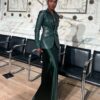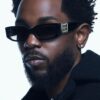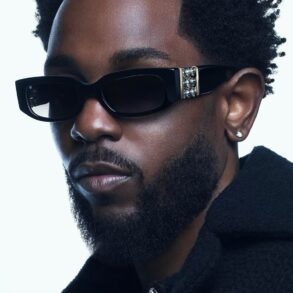It may be the spring season, but that didn’t stop the designers at New York Men’s Day from breaking out the suits. Although their interpretation of the menswear staple was anything but traditional, the trend toward tailoring was evident during the showcase, which kicked off New York Fashion Week on Friday.
New York Men’s Day, created by Agentry PR and sponsored this time by Hilldun Corp., presented 10 designers at two separate sessions: A.Potts, B|M|C, Clara Son, Kent Anthony, Terry Singh, Raleigh Workshop, Sebastien Ami, Skyco, The Salting and Tarpley.
The formal looks showed up in a number of different forms — everything from a conventional tuxedo over a silk formal shirt at B|M|C to short skirts worn with formal jackets at Terry Singh. Here, a few of the standouts:
At A.Potts, designer Aaron Potts looked to the streets of New York for his inspiration, creating a collection that offered a balance of urban meets the outdoors.
“This collection, I called it ‘Urban Earth,’” he said. “I had this vision of when you’re walking down the street in New York City, the concrete — it’s kind of gross — but then you see that little sprig of green coming up through the crack. That’s sort of the spirit that I wanted to capture.”
The inspiration came through in the collection’s color palette, which juxtaposed navy and black pieces with neon orange and gold foil styles.
As the designer leans toward more casual wear, he debuted a few styles that he described as “casual chic suits,” which were soft tailored separates made in a black draped style and an oversize denim look.
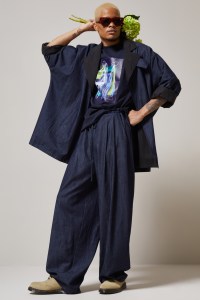
A.Potts RTW spring 2024
Courtesy of A.Potts
Kent Anthony leveraged his background in track and field for spring, taking inspiration from it for the softly tailored styles.
“You’ll see a collection of things that are reminiscent of the energy and the feel of the 100-meter race and the movement and flow, as well as the physical structure of the track,” he explained. “So, strong vertical lines are kind of abstracted in some of the looks here. And the other looks, we start to get more into the structure of the track. We worked with our classic silhouette, so shorter jackets, longer legs and broader shoulders — kind of reminiscent of an athletic build or a short sprinter’s body.”
Anthony utilized a vertical stripe motif throughout on pieces like a structured cobalt blue jacket and short-sleeve button-up shirts to tie the pieces into the track and field inspiration.
The designer noted his key pieces are a beaded leather look that he stated evokes the high energy of a track, as well as a black top designed with hand-painted panthers, which gave a nod to his fine arts background.

Kent Anthony RTW spring 2024
Courtesy of Kent Anthony
Terry Singh continued his mission of championing skirts for men, which he was inspired to make based on a follower’s message.
“Two years ago, a young man from Brazil sent me a message and said he loved the work that I’m doing,” Singh said. “But, in Brazil he wouldn’t be able to wear it because even though Brazil is culturally and religiously open, men’s skirts aren’t going to work for him with his family and friends.”
Singh took that inspiration and gave it a military spin to create utilitarian-inspired skirts designed in an army green hue with multiple layers and flaps. He also looked to hockey uniforms to create skirts with a sporty flair.
The designer also wanted to introduce a short-skirt suit option for men, taking inspiration from the short suits that are available for women.
“We have to make skirts an everyday thing for men,” he said. “Like, why do we only have pants? I keep working on it every year and every collection, so we’ll keep going.”

Terry Singh RTW spring 2024
Courtesy of Terry Singh
Brandon Murphy offered up the most traditional take on tailored clothing for his B|M|C spring offering. This season, he used silks and other “elegant textiles” in everything from long coats to high-waisted pants with matching jackets. There were shawl-collared shirts that were a play on the classic jacket silhouette, but “more comfortable,” he said — another hallmark of the spring line.
Murphy included a cropped jacket over double-pleated shorts with a sash down the back as a way to straddle both streetwear and tailoring. He used the same sash treatment on a white silk suit.
“This collection is an exploration of self-confidence and sensuality,” he said. “For me, clothing is a big part of identity and dictates my mood and how I feel.”
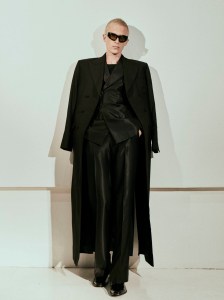
B|M|C RTW spring 2024
Courtesy of B|M|C
Whether it was avant-garde European artists after World War II or American designers after a pandemic, many creatives exited New York City after life-altering events to embrace the more peaceful confines of Long Island. That’s what happened to Michael Ward and Manel Garcia Espejo, creative directors of The Salting, who moved out east into a more serene and larger studio to create their spring collection.
In their debut showing at New York Fashion Week the duo turned to painter Betty Parsons and her raw yet refined stripe applications on wood and stone as the starting point for their fabric development for the genderless collection.
Already known for their tunics and caftans, the married couple evolved the look this season by playing with the neckline and using bright colorblocking to update the neutral palette. A jumpsuit featured oversize proportions with a super wide leg and U-shaped pockets that they offered in both khaki and navy. “It’s the new uniform of the season,” Ward said. In addition, they used a colorful tweed fabric in a variety of styles, ranging from jackets to shorts, but in a twist, paired it with a traditional khaki to give the pieces a fresh feel.

The Salting RTW spring 2024
Courtesy of The Salting
Raleigh Workshop has a commercially successful business, but what Victor Lytvinenko brought to his fifth showing at New York Fashion Week was not that. Instead, the Raleigh, North Carolina, creative offered up an assortment of one-offs that he created in his studio for — and with — his friends and muses.
“It’s really a collection of collaborations,” he said. For example, a sculptor friend dripped molten metal on some fabric, creating holes, and Lytvinenko made a jacket and pants out of it. Similarly, he built a one-of-a-kind blazer with tags on the exterior from a bolt of Harris tweed from 1959 for another artist friend and printed tie-dyed jeans for another. He said the collaborations influence his ready-to-wear.
But while these works were more like art projects, Lytvinenko has to make a living, too, so he also used the presentation to introduce a $100 made-in-America jean, the R100. “I’ve been working on it for 10 years,” he said.
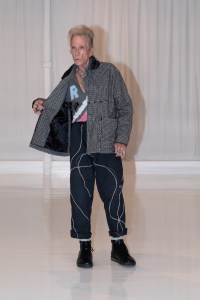
Raleigh Workshop RTW spring 2024
Courtesy of Raleigh Workshop
Tarpley Brooks Jones, a newcomer to NYMD, presented his inaugural collection for his brand Tarpley, aptly titled “Software” — with the notion of harnessing and recontextualizing natural fabrics such as organic cottons and linens to transform them into technical garments that skew to the utilitarian space.
Each look was a riff or meme from Jones’ background, such as the Tennessee farmer at fashion week, who donned a technical jacket worn over an anorak and tech shorts with oversized front patch pockets with zippers; the hiker who completed his climb on Mount Rainier — in a color-blocked tech jacket with multiple tech cargo pockets (some oversized) — and then the rapper who crashed a CFDA party, in a cozy waffle knit hoodie and black technical pants, bridging cozy loungewear pieces mixed with elevated and technical details.
Key pieces included a “hunting jacket” (or farmers jacket) composed of a bio linen, the waffle hoodie in cream, and Jones’ interpretation of a suit — this one with an asymmetric cut twill jacket, tech cummerbund and matching pants with snaps at the bottom.
The designer revealed he will be releasing a women’s range, with a target date of October.
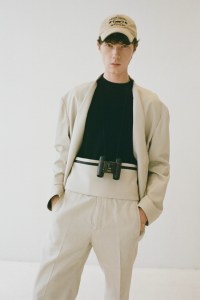
Tarpley RTW spring 2024
Courtesy of Tarpley
Another newcomer to NYMD was Sebastien Ami, co-designed by Haitian-American artist and designer Sebastien Amisial and his spouse Marianne Brehmer Amisial. The L.A.-based brand may be relatively new but it has already been picked up by Ssense and worn by Justin Bieber. The brand launched in 2017 but didn’t really begin to flourish until the COVID-19 era.
The brand is centered around vintage-inspired garments, taking design cues from midcentury Americana, German utilitarianism, and Shōnen manga-inspired Japanese workwear. Handmade in Los Angeles, the duo’s collections are known for their relaxed T-shirts, classic pleated shorts, and mid-layer shirts.
This season’s message homed in on “Togetherness” with the idea that every item can be mixed and matched. Cropped denim jackets with a slight voluminous shape, oversized fatigue jackets with the same fabrics used on classic M65 jackets (from the Vietnam era), below-the-knee cargo shorts with oversized cargo pockets and pleated oversized shorts were some of the highlights.
Another standout was a shirt style with kimono-like sleeves, composed in a cotton textile reminiscent of a traditional Haitian shirt, finished with a crochet-like pattern in the center. Another reference to his Haitian upbringing can be seen on sashes done up in a cotton fabric, adorned over a classic field jacket.

Sebastien Ami RTW spring 2024
Courtesy of Sebastien Ami
This post was originally published on this site be sure to check out more of their content.

